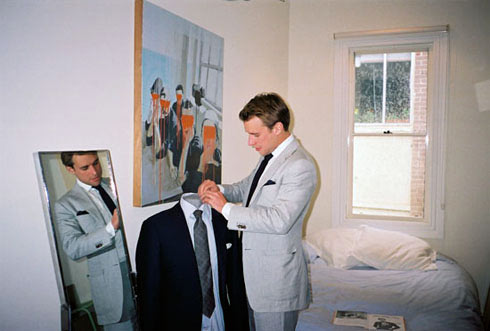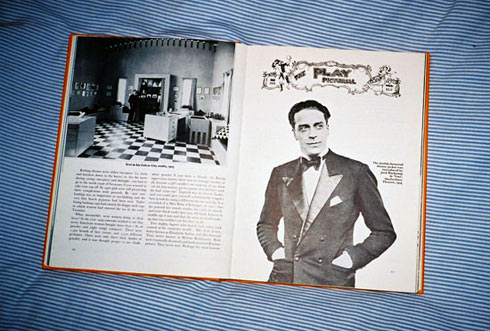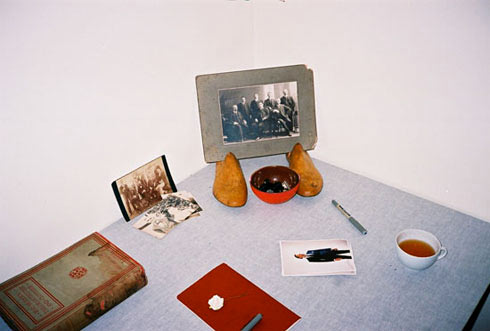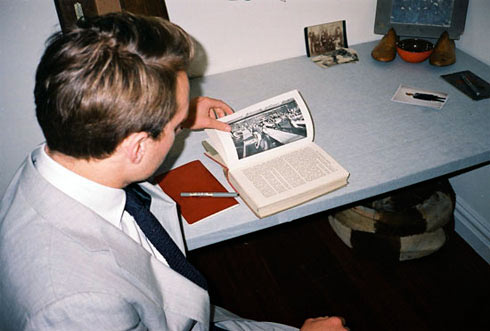Following Suit




 Words: Caroline Clements Images: Tristan Ceddia
Words: Caroline Clements Images: Tristan Ceddia
Now I am of the opinion that every man should, at some point, have a tailor-made suit. For it is not the man that makes the suit, but the fine suit that makes the man look devilishly handsome, especially one that fits him perfectly. It’s a bit like Cindarella – he will become a prince of course – only he won’t turn into a pumpkin if he’s not home by midnight wearing it.
There is something quite charming about a bespoke suit, and a tailor who will measure you up and down. The Blackmail speaks to a cavalier young chap who does just this, Patrick Johnson of Suit Shop.
Today he’s wearing a light grey cotton suit that is half lined with a very soft shoulder (pretty much no padding at all), with a crisp white fine twill cotton shirt. “I like this suit because I can wear it casually with plimsolls, or formally with dark brown suede brogues and a nice cashmere tie,” comments Johnson. “I wear a white fine twill shirt most days. I love this material because it doesn’t crease much, it’s soft, stays bright white and it really lasts.”
A man of refined taste, Johnson was originally trained as a wine maker, but soon turned to the rag trade to bear threads. A relatively young man in his endeavours, he made his first suit five years ago – a three-piece navy linen summer suit, he recalls. “I was living in London at the time, working just down the road from Savile Row (aka. The Golden Mile of Tailoring) on Jermyn St.” Savile Row is a community of tailors, shoe-smiths and accessory makers that stretches far beyond ‘The Row’ itself. In the area every day, he couldn’t help but be influenced by all that was going on, but his initial style influences came from his step-father – a man who colour coordinated his own tie collection.
At Suit Shop, the intention is to construct pieces that fit with the climate and lifestyle in Australia, which are functional but have character. Johnson likens the process to wine in that respect. “First dictated by the climate then by the consumer’s taste and lifestyle and finally you have the makers signature’s.” Suit Shop works predominantly with Australian merino wool. “Wool is great because it’s crease resistant, has natural stretch and is durable and comfortable.” Using old sartorial techniques, Johnson tends to go easy on the heavy padding and bulky lining, setting out to construct garments where their is synergy between the wearer and the suit. And with his main clientele being professionals – bankers and lawyers, architects, designers and advertising executives – he must allow for people who travel regularly and usually want something that creases less and is more durable.
What is typical of a Suit Shop suit is the particular detailing, and it is these such details that the tailor communicates to the public. “From a few details of a suit you can tell where it was made, and in most cases, who has made it.” He uses hand stitched padded lapels on his jackets, like those you see on Humphrey Bogart or in films like Casablanca, where the lapels have a rounded, natural appearance, rather than a sharp fold. This is achieved by a thin layer of cotton sewn into a gently rounded shape with thousands of tiny stitches. Then he finishes his sleeves with buttons sewn on by hand, kissing each other in the traditional Italian way. The options for trimmings are endless however. From linings to buttons, stitch colour, pocket types, vents, pleats, cuffs and belt loops. The goal is to use these options to create balance in the suits. By adding a bit of the client’s personality and a bit of the Suit Shop touch, you are creating something together.
Suit Shop is mostly a one-man operation on our home shores, but unlike his well-fitting ensembles, there is certainly room for growth. Johnson utilises the fantastic weaving skills of his European colleagues, buying the bulk of the materials from two Italian makers, Loro Piana and Zegna, also using some makers in the UK and Switzerland for casual cottons, linens and cashmeres. Whilst citing Italians as some of the most stylish people, Johnson prefers an English business look for his suits, but suggests that they use far too much padding and far too heavy a lining for the weather conditions here in Australia. He tends to strip down the bulkiness of the padding to use a lighter canvas in the chest and shoulder (as in southern Italy). “I cut my arms slim and shoulders close. The trousers flow on from the jacket to give an elegant drape.” As a result, a Suit Shop suit looks markedly sharper than any suit you might buy of the rack.
With this ever-so-well clad gentlemen to my side, I pose a final query on a dressing rule another gentlemen imparted to me recently – never button up a suit jacket that isn’t tailor made, for it accentuates the imperfect fit of the garment. Johnson sets me straight, the rule of thumb here stands true, most of the time. The main reason is that most people have one shoulder that is sloping lower than the other. This is usually a result of playing racquet sports, ball sports or rowing, and subsequently the button-hole on the jacket hangs lower than the button. A most vital rule to follow, however, is the ‘sometimes, always, never’ rule, that applies to buttons on a suit jacket in descending order.
With style icons to take note from that include the Duke of Windsor and the late Gianni Agnelli, its no wonder this man is so dapper. He doesn’t wear a handkerchief up his sleave because he cuts the sleeve in his shirts far too skinny to fit one, but prefers to wear a pochette (pocket hanky) in his breast pocket and another folder in his trouser pocket. If only top hats weren’t so tricky to travel with, you can bet he’d be wearing one too.
More from Suit Shop here
Next Article



